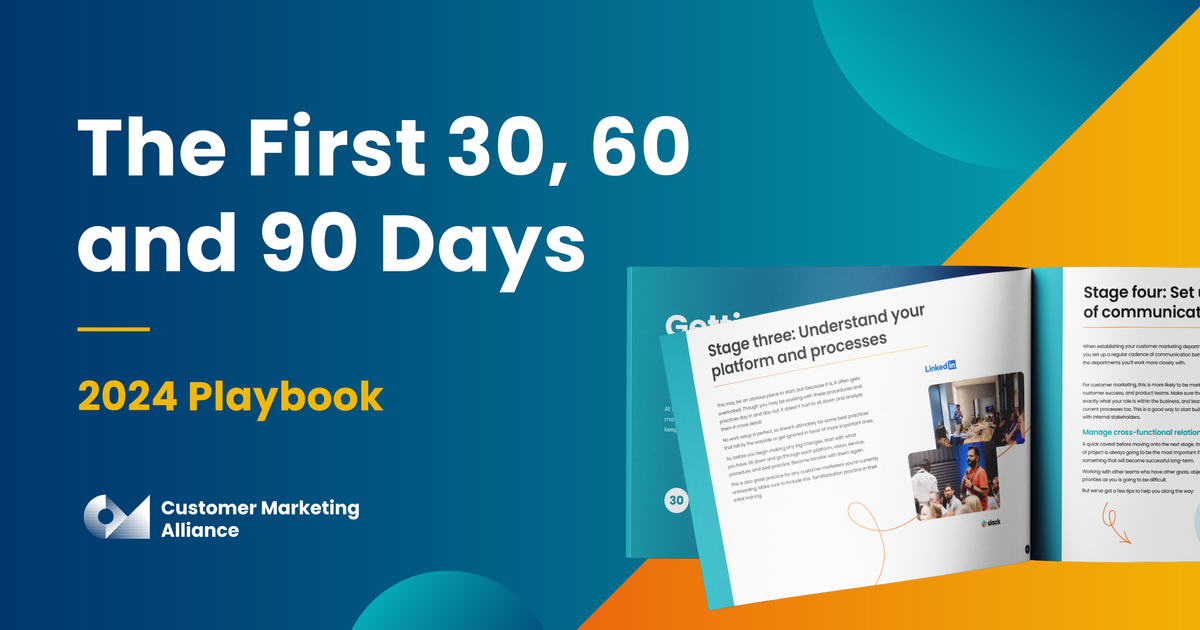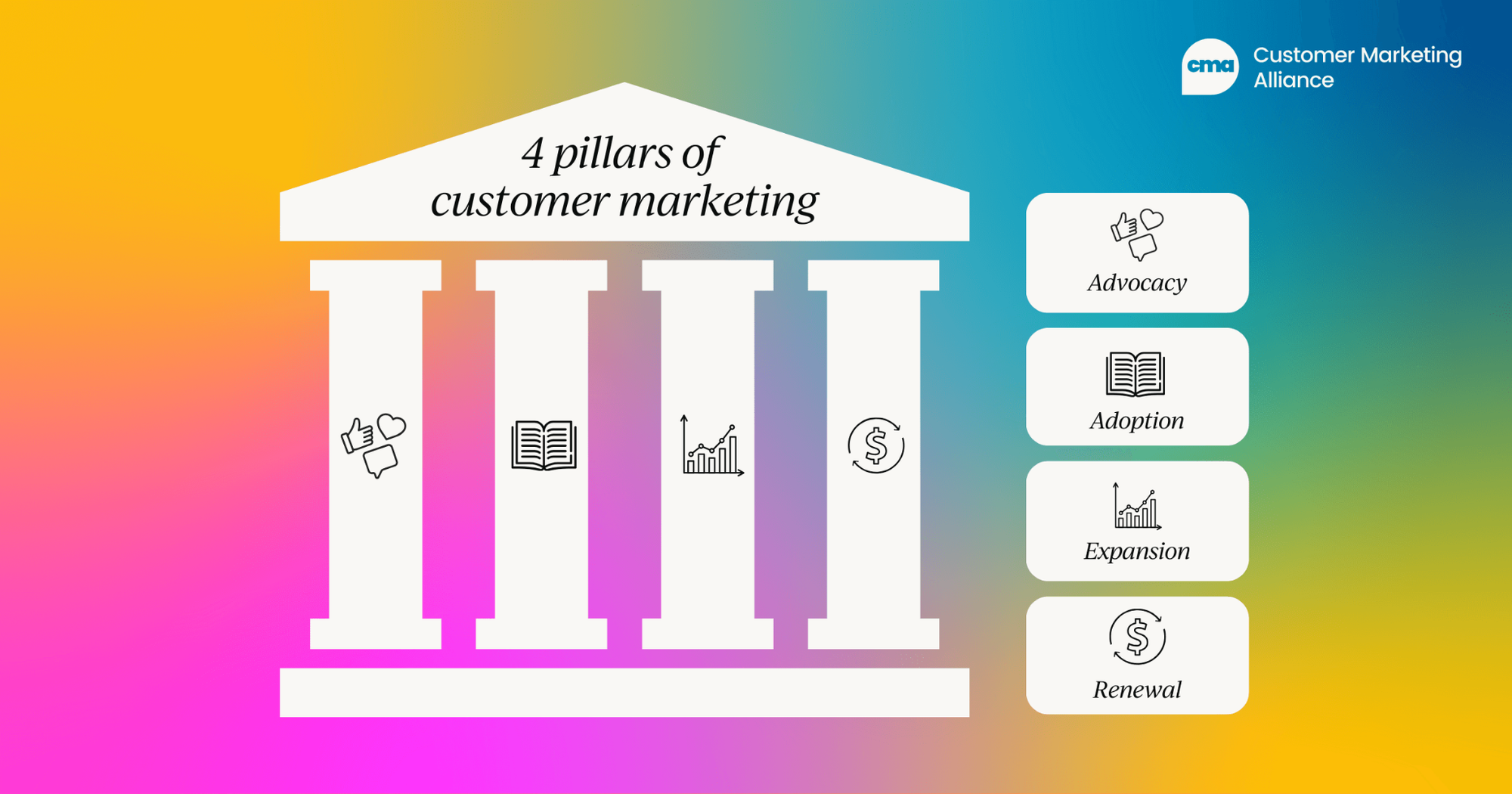While an NPS score offers a snapshot of customer sentiment, the actions you take in your first 90 days are what truly drive future growth and loyalty.
The journey you embark on – from initial planning to program execution – is what creates a loyal customer base that will improve your NPS over time, not the other way around.

Getting started: Your first 30 days in customer marketing
So, you're tasked with building a customer marketing function from scratch. It might sound daunting, but don't sweat it.
The first 30 days are all about setting yourself up for success. You’re not launching anything huge yet; you’re just building a solid foundation.
Find your "why"
First things first, you need to understand the big picture. Why is this new team being created? Is your leadership trying to boost customer retention, increase customer lifetime value, or maybe just beat a competitor to the punch?
Whatever the reason, you need to get to the core of it. For example, if the goal is to improve onboarding, you have to talk to everyone involved – sales, marketing, customer success – to understand what "successful onboarding" means to them.
It's important to know that a lot of what customer marketing does has historically been handled by other teams. Your job is to step in and manage the customer relationship after the initial sale.
Unlike other teams, you're not trying to sell the customer something new or just get feedback. You’re building a long-term relationship.
This is why building strong relationships with other teams is so crucial. By collaborating from day one, you can avoid conflicts and make sure your work helps them achieve their goals, too. Think of it as a win-win.
Gather your resources
Now, you need to figure out what you have to work with. This means looking for people and tools both inside and outside the company.
- Inside: Chat with HR to see if any current employees have the skills you need. Work with your existing marketing team to see who can help, and talk to your sales team for their insights into customer behavior. You can also tap into your company's employee skills database to find hidden talent. Don't forget, offering training and development can turn an interested employee into a valuable team member.
- Outside: If you need to hire, use job boards or work with a specialized recruitment agency. You can also bring in freelancers from platforms like Upwork for specific projects. External consultants and advisors can also be a huge help in getting your function off the ground.
Build your business case
Even if you have initial buy-in from leadership, you still have to fight for resources. The best way to do this? With data. Customer marketing is a unique blend of building personal relationships and making data-driven decisions.
Data is the language of leadership.
- Create a dashboard: Build a simple dashboard to show how your programs are impacting key metrics like revenue and retention.
- Use data to strategize: Don't just collect data; use it to figure out how to drive more growth and engagement.
- Track the right metrics: Pay attention to things like program penetration (how many customers are in your programs), advocates per account, time to engagement, and retention.
By leveraging data, you can prove that customer marketing isn't just a nice-to-have; it's a must-have for the business.
Understand the four pillars
Finally, it's time to build your strategy around the four pillars of customer marketing.
- Advocacy: Find your biggest fans, segment them, and figure out how to get them to champion your brand.
- Customer communications and adoption: Decide on your core message and make sure it’s reflected in all your communications.
- Expansion: Look at past campaigns to see what worked, and talk to the sales team about what assets they prefer.
- Renewal: Focus on customers who have churned or are at risk of churning. Use surveys to understand their pain points.
By the end of your first month, you’ll have a clear plan, the right people, and a solid understanding of how to make your customer marketing function a success.

Executing the plan: Your next 60 days
With the groundwork laid, the next 60 days are all about action. It's time to take your research and planning and turn it into real-world programs and goals that will make a difference.
Define your goals for advocates
The best way to start is by talking to your customers. Set up interviews with your current advocates to build rapport and get valuable insights.
A great way to streamline this is to work with customer success to create an advocate nomination process. This makes it easy for other teams to suggest great candidates for customer stories.
When setting your goals, make sure they have these four key components:
- Brand awareness: Make sure your goals align with your company's overall brand voice.
- Impact: Every goal should be about improving an existing process.
- Metrics for success: You can’t hit a target you can't see. Define exactly how you’ll measure success.
- Time frame for completion: Goals need a deadline, or they just become vague tasks that never get done.
You can use frameworks like CLEAR (Collaborative, Limited, Emotional, Appreciable, Refinable) or SMART (Specific, Measurable, Attainable, Relevant, Time-bound) to structure your goals.
Another great option is OKR (Objectives and Key Results), which helps you set ambitious objectives and track your progress with measurable results.
Map out the customer journey
It's time to build a plan to communicate with customers and collect their stories. A crucial part of this is mapping out the customer journey.
As Brooke Wilson from AlphaSense explains, it's a "visual representation of all of the touchpoints, all of the actions, the emotions, the feelings customers are going through."
A great customer journey map should be:
- Seamless: It should provide a smooth experience for the customer.
- Data-driven: All decisions should be based on data.
- Continuously improving: It should be a living document that you update over time.
- Focused on loyalty: It should always prioritize customer loyalty and advocacy.
By mapping the journey, you'll be able to create messaging that is unique to each stage, ensuring a more personalized and effective experience for your customers.
Plan your events and communications
Now you can start planning bigger content pieces and events. Consider a "Launch & Learn" workshop for new product updates, where customers get hands-on experience and advice.
Work with other teams to find "white space" in your target accounts – that is, customer goals and challenges your business can solve. You can also use marketing automation to create email sequences that collect information from customers based on their behavior.
For your communication plan, use customer segmentation to your advantage. For example, you can segment at-risk customers and send them targeted email campaigns to try and win them back. This is also a great time to develop a regular survey cadence to collect feedback from your customers at key moments.
By the end of 60 days, you'll have a strategic plan, a library of customer stories, and a foundation for the programs that will define your customer marketing function. Now, get ready to launch!
Maximizing efficiency: Your first 90 days
You’ve hit the 90-day mark! This is the big moment. It’s time to deliver on your strategy, launch your programs, and start measuring their success. This is where all your hard work pays off.
Launch your programs
Now's the time to roll out specific programs for advocacy and more.
- Customer communities: These are a fantastic starting point. Free platforms like Slack let you create a flexible space for customers to connect with each other and your brand. It's great for transparency and promotion.
- Ambassador programs: For your biggest fans, offer an exclusive ambassador program. They'll create user-generated content for you, and in return, they get a look behind the scenes and sweet deals.
- Customer reference program: Share your new customer reference program with the sales team. The voice of your customers is incredibly powerful, so make sure to collect and share testimonials both internally and externally.
- Customer story library: Launch a central library for all your customer stories. This gives all your teams a bank of quotes, testimonials, and case studies to use whenever they need them.
You should also launch programs focused on expansion and renewal.
- Lifecycle campaigns: Set up trigger-based campaigns for new customers to help them learn about and adopt your product.
- Detractor programs: Follow up on customer complaints from surveys to address their pain points and work to prevent churn.
- Targeted emails: Send emails to inactive users to re-engage them and remind them of your brand's value.
- Customer appreciation events: Throw a dinner or host an event to thank customers for their loyalty.
Track your goals
Now that you've done all this, the most important thing is to measure your progress.
- Advocate metrics: Keep an eye on the number of new advocates and their retention rate. Also, track things like reference calls, reviews, and referrals.
- Qualitative progress: Use tools like Salesforce to measure your influence on sales cycles.
- Other metrics: Count the number of events you’ve hosted, reviews you’ve gotten, and customer stories you’ve collected.
To make sure you’re tracking the right things, follow Kevin Lau's advice:
- Ask the right questions: Figure out what you can easily measure, what will have the biggest impact, and what your leadership cares about.
- Set shared goals: Talk to marketing, sales, and customer success to align on shared goals.
- Commit to "North Stars": Choose a few key metrics to guide your programs, such as a customer adoption score, community engagement score, or advocacy score.
Building a customer marketing function takes time and patience, and it's an ongoing process. But by setting clear goals, aligning with your partners, and consistently tracking your progress, you'll be well on your way to building a function that becomes a core driver of business growth.
A high NPS score is a great outcome, but it’s a lagging indicator of success. The work you do in the first 90 days – building relationships, creating programs, and proving value – is what truly drives the business forward and earns that high score.


 7 min read
7 min read
 Follow us on LinkedIn
Follow us on LinkedIn




